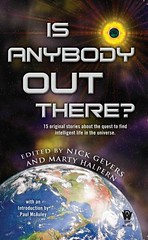 |
| Henry Thomas stars in Steven Spielberg's E.T.: The Extra-Terrestrial (courtesy of Universal/Everett) |
The Daily Galaxy (@dailygalaxy) posted an article online on June 20, 2010, entitled "Invisible Extraterrestrials? World Leading Physicist Says 'They Could Exist in Forms We Can't Conceive.'" The physicist to whom the article refers is Lord Martin Rees, president of Britain's Royal Society and astronomer to the Queen of England. Earlier, in May, Lord Rees hosted a National Science Academy Conference -- "The Detection of Extra-terrestrial Life and the Consequences for Science and Society" -- at which he stated that he believes the existence of extraterrestrial life may be beyond human understanding. To quote Rees directly:
"They could be staring us in the face and we just don’t recognize them. The problem is that we’re looking for something very much like us, assuming that they at least have something like the same mathematics and technology.
"I suspect there could be life and intelligence out there in forms we can’t conceive. Just as a chimpanzee can’t understand quantum theory, it could be there are aspects of reality that are beyond the capacity of our brains."
Also participating in this conference was noted SETI-founder Frank Drake (of the Drake equation fame), who presented an interesting theory on how the "digital revolution" is making humanity invisible to aliens by cutting [to the vanishing point] the transmission of analog TV and radio signals into space.
The article goes on to define three propositions to explain why "there is no direct and/or widely apparent evidence that extraterrestrial life exists." If you're intrigued with all of this, then by all means please read the entire Daily Galaxy article, including the Comments section, in which a reader suggests a fourth proposition.
Last week, while visiting "the mom" in a medical rehab facility (see blog post dated Friday, July 23, 2010), I managed to steal away for a few hours to meet my friend -- and author -- Bruce McAllister for dinner. The last time we got together (during the Thanksgiving holiday last year), the anthology Is Anybody Out There? was still a work in process. But now that it has been published, I was able to chat with Bruce about the many reviews, in addition to the Readercon book launch. Then, a few days ago, on July 27, Bruce sent me an email with only a lone link attached -- to a TIME online piece entitled "Listening for Aliens: What Would E.T. Do?"
The article focuses on the work of Gregory Benford, professor of physics at the University of California at Irvine and an award-winning science fiction writer, his twin brother James, and James' son Dominic. The Benfords have been rethinking the SETI project, which now marks its 50th year.
After exhaustive analysis, the Benfords believe that aliens who want to be detected would most likely send out short, powerful bursts every so often rather than continuous transmissions. Unfortunately, these "Benford beacons" would be easy to miss if scientists weren't listening right at that exact time. The article concludes with an extrapolation:
"Of course, all the new work [on SETI] may be unnecessary, since it's just possible we've spotted E.T. already. Several times over the past 50 years, searchers have picked up radio signals that flashed once or twice, then disappeared. The best known of these is called the 'Wow' signal, because that's what an astronomer who picked it up wrote on a printout from a radio telescope at Ohio State University in the 1970s. SETI searchers went back to the star in question immediately, but heard nothing. It may well be, suggests Benford, that we detected extraterrestrials more than three decades ago — and because we weren't taking into account what E.T. would do, failed to confirm it."
All this is great stuff: food for thought, grist for the mill, and confirmation that we -- all the contributors -- done a good thing with the publication of Is Anybody Out There? to commemorate the 50th anniversary of the SETI project.


